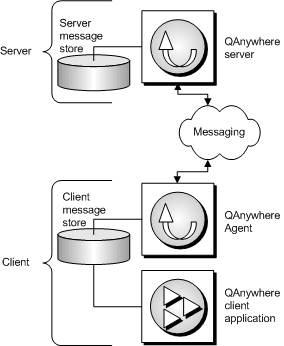A simple QAnywhere messaging setup is illustrated in the following diagram. For simplicity, only a single client is shown. However, a typical scenario has multiple clients with the server message store existing to transmit messages between them.

This setup includes the following components:
Server message store At the server, the messages are stored in a relational database. The database must be set up as a MobiLink consolidated database, and may be any supported consolidated database.
Client message store The messages at each client are stored in a relational database. QAnywhere supports SQL Anywhere and UltraLite databases. SQL Anywhere databases are recommended for data synchronization applications. UltraLite databases are recommended for applications used exclusively for storing and forwarding messages.
QAnywhere server The QAnywhere server is a MobiLink server that is enabled for messaging. MobiLink synchronization provides the transport for transmitting and tracking messages between QAnywhere clients and the server. MobiLink provides security, authentication, encryption, and flexibility. It also allows messaging to be combined with data synchronization.
To start the QAnywhere server, start the MobiLink server with the -m option. See Starting QAnywhere with MobiLink enabled.
QAnywhere Agent The QAnywhere Agent manages the transmission of messages on the client side. This process is independent of QAnywhere client applications.
QAnywhere client application An application written using the QAnywhere C++, Java, or .NET API makes method calls to send and receive messages. The basic object used by the client application is the QAManager.
Messages are sent and received by QAnywhere clients. Messages at the server are not picked up until the client initiates a message transmission. QAnywhere clients use policies to determine when to perform a message transmission. Policies include on demand, automatic, scheduled, and custom. The on demand policy permits the user to control message transmission. The automatic policy initiates a message transmission whenever a message to or from the client is ready for delivery. The custom policy uses transmission rules to add further control over message transmission.
See Determining when message transmission should occur on the client.
| Send feedback about this page via email or DocCommentXchange | Copyright © 2008, iAnywhere Solutions, Inc. - SQL Anywhere 11.0.0 |